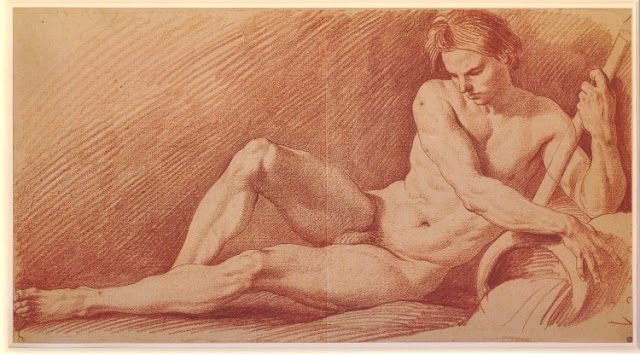 |
| Anonymous Italian artist Two Easter Eggs (open and closed) ca. 1716 drawing British Museum |
 |
| Anonymous Italian artist Pontifical ring with square-cut sapphire given by Sixtus V to St Charles Borromeo ca. 1700-1725 drawing British Museum |
"The gifting of art in early modern Rome represented an opportunity to bestow honor and demonstrate obligation in an elaborate performance of rank and identity. In 1610, for example Francesco Maria II della Rovere, Duke of Urbino, sent Cardinal Michelangelo Tonti a diamond-encrusted cross-shaped reliquary and Cardinal Scipione Borghese a "beautifully ornamented" painting by Federico Barocci. Observers noted that the duke's lavish gift was enough to secure for his courier a guided tour through a suite within the Borghese palace. Other visitors were not as lucky, being admitted to only a single room of the palace."
:"The presentation to men of lesser rank might be performed in a display of spontaneous largesse, and the gifts might be wholly without ornament – as when Sixtus V, during a visit from Camillo Strozzi on behalf of the Duke of Mantua, Guglielmo Gonzaga, reached into a small box of ancient medals and, placing a handful of them on a paper sheet, presented them to Strozzi to give to members of the ducal family."
– from The Social Aesthetics of the Gift by Frances Gage, published in Display of Art in the Roman Palace 1550-1750, edited by Gail Feigenbaum (Getty Research Institute, 2014)
 |
| François Boucher Profile of a girl 18th century drawing Ashmolean Museum, Oxford |
 |
| Joshua Reynolds Details of paintings, from Italian sketchbook 1752 drawing British Museum |
 |
| Joshua Reynolds Drawing of sculpture, from Italian sketchbook 1752 drawing British Museum |
 |
| Louis Chéron Académie with drawing board early 18th century drawing British Museum |
 |
| Ozias Humphry Académie late 18th century drawing British Museum |
 |
| Joshua Reynolds Académie 1770s drawing British Museum |
 |
| François Boucher Study for Sleeping Venus 18th century drawing British Museum |
 |
| Edmé Bouchardon Study for River God mid-18th century drawing British Museum |
"Why does a beautiful sketch accord greater pleasure than a beautiful painting? Because it has more life and fewer forms. The more forms one introduces, the more life disappears. In a dead animal, an object hideous to view, forms are present but life is absent. In young birds, small cats, and various other animals, the forms are still obscured but everything is full of life; thus they please us very much. Why is it that a young student incapable of making even a mediocre painting can make a marvelous sketch? Because such sketches thrive on enthusiasm and genius, while paintings demand work, patience, prolonged study, and extensive technical expertise. Who knows that of which nature herself seems to be unaware, how to introduce the forms of advanced age while conserving the liveliness of youth?"
– Denis Diderot, from the Salon of 1767, translated by John Goodman (New Haven : Yale University Press, 1995)
 |
| Anonymous Russian artist Figure study 18th century drawing British Museum |
 |
| Anonymous Russian artist Figures in combat 18th century drawing British Museum |
 |
| Gian Paolo Panini Denial of Peter 18th century drawing British Museum |
 |
| Anonymous Italian artist Portrait of a Venetian Senator 18th century watercolor on vellum British Museum |